TAXATION Assignment: CGT, Fringe Benefits, and Tax Implications
VerifiedAdded on 2023/06/04
|13
|4038
|216
Homework Assignment
AI Summary
This TAXATION assignment solution addresses two key issues: capital gains tax (CGT) implications and fringe benefits tax (FBT) liabilities. The first question examines the tax treatment of Amber's chocolate shop sale, including goodwill, equipment, and trading stock, as well as proceeds from a restrictive covenant and the sale of an inherited apartment, considering the main residence exemption. The second question delves into the tax treatment of various benefits provided by Houses R Us to its employee Jamie, including base salary, commissions, a company car, and a loan, assessing assessable income, potential deductions, and FBT calculations for both the employer and employee. The solution analyzes relevant sections of the Income Tax Assessment Act 1997 and the Fringe Benefits Tax Assessment Act 1986, providing detailed legal applications and conclusions for each scenario.
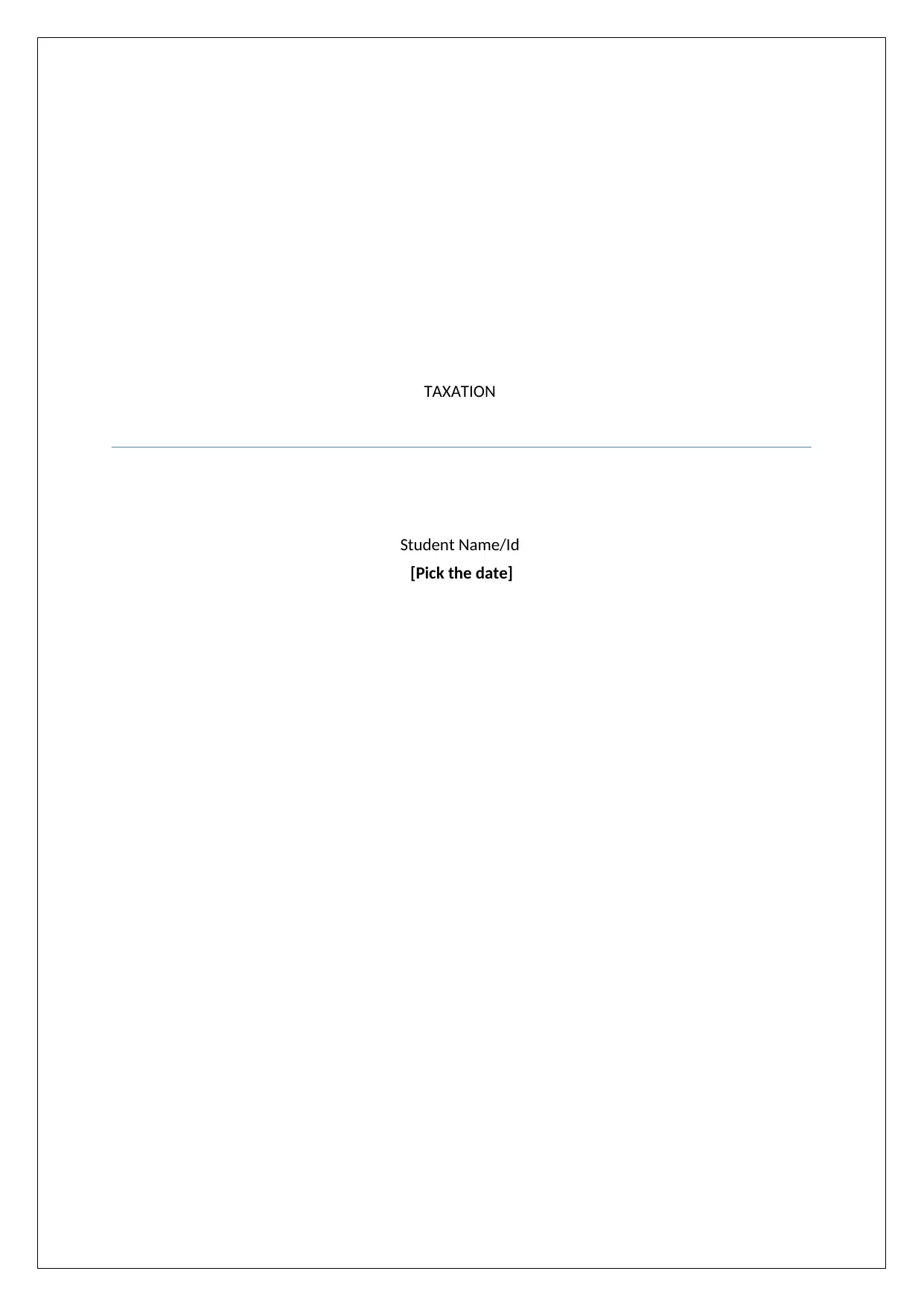
TAXATION
Student Name/Id
[Pick the date]
Student Name/Id
[Pick the date]
Paraphrase This Document
Need a fresh take? Get an instant paraphrase of this document with our AI Paraphraser
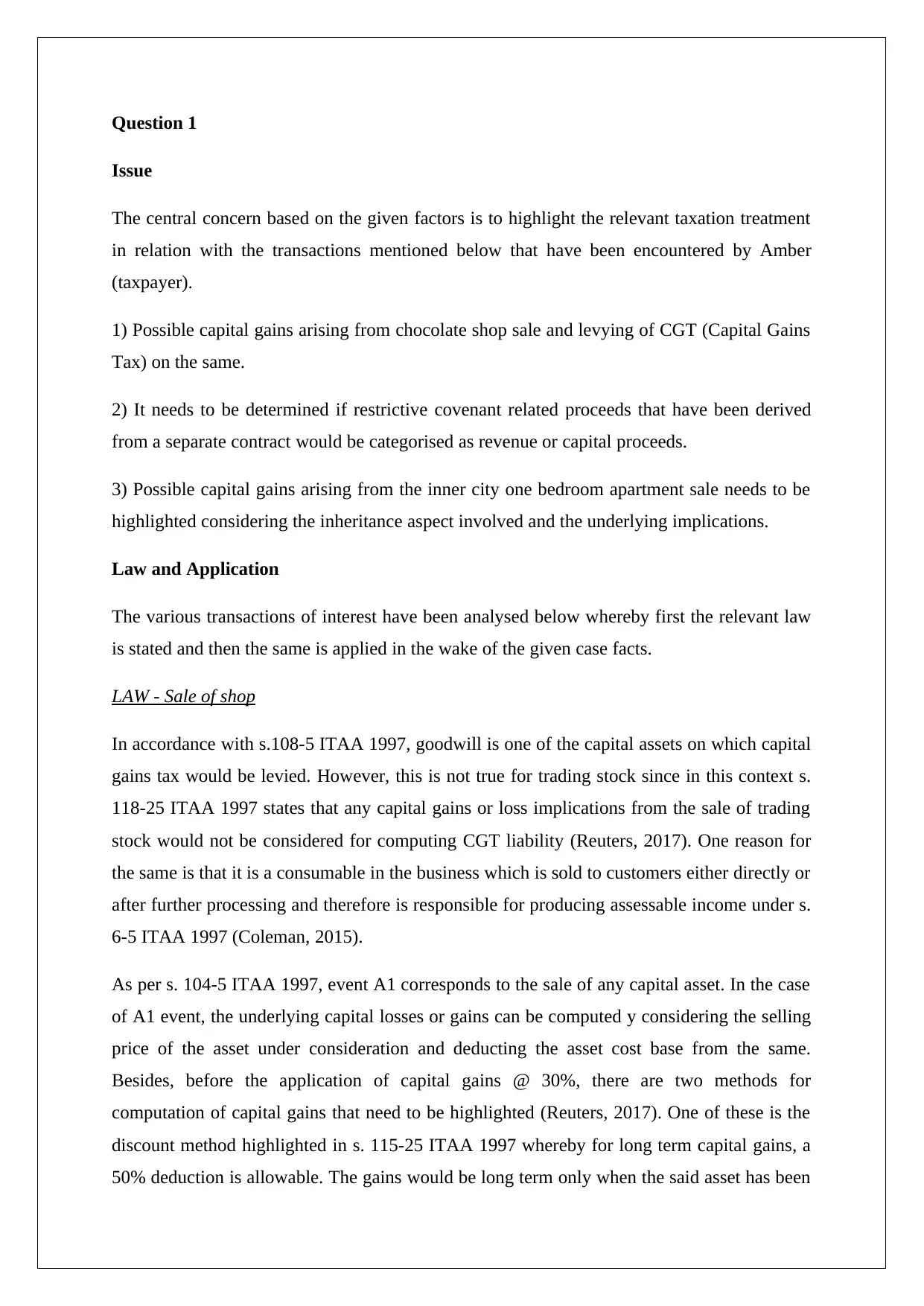
Question 1
Issue
The central concern based on the given factors is to highlight the relevant taxation treatment
in relation with the transactions mentioned below that have been encountered by Amber
(taxpayer).
1) Possible capital gains arising from chocolate shop sale and levying of CGT (Capital Gains
Tax) on the same.
2) It needs to be determined if restrictive covenant related proceeds that have been derived
from a separate contract would be categorised as revenue or capital proceeds.
3) Possible capital gains arising from the inner city one bedroom apartment sale needs to be
highlighted considering the inheritance aspect involved and the underlying implications.
Law and Application
The various transactions of interest have been analysed below whereby first the relevant law
is stated and then the same is applied in the wake of the given case facts.
LAW - Sale of shop
In accordance with s.108-5 ITAA 1997, goodwill is one of the capital assets on which capital
gains tax would be levied. However, this is not true for trading stock since in this context s.
118-25 ITAA 1997 states that any capital gains or loss implications from the sale of trading
stock would not be considered for computing CGT liability (Reuters, 2017). One reason for
the same is that it is a consumable in the business which is sold to customers either directly or
after further processing and therefore is responsible for producing assessable income under s.
6-5 ITAA 1997 (Coleman, 2015).
As per s. 104-5 ITAA 1997, event A1 corresponds to the sale of any capital asset. In the case
of A1 event, the underlying capital losses or gains can be computed y considering the selling
price of the asset under consideration and deducting the asset cost base from the same.
Besides, before the application of capital gains @ 30%, there are two methods for
computation of capital gains that need to be highlighted (Reuters, 2017). One of these is the
discount method highlighted in s. 115-25 ITAA 1997 whereby for long term capital gains, a
50% deduction is allowable. The gains would be long term only when the said asset has been
Issue
The central concern based on the given factors is to highlight the relevant taxation treatment
in relation with the transactions mentioned below that have been encountered by Amber
(taxpayer).
1) Possible capital gains arising from chocolate shop sale and levying of CGT (Capital Gains
Tax) on the same.
2) It needs to be determined if restrictive covenant related proceeds that have been derived
from a separate contract would be categorised as revenue or capital proceeds.
3) Possible capital gains arising from the inner city one bedroom apartment sale needs to be
highlighted considering the inheritance aspect involved and the underlying implications.
Law and Application
The various transactions of interest have been analysed below whereby first the relevant law
is stated and then the same is applied in the wake of the given case facts.
LAW - Sale of shop
In accordance with s.108-5 ITAA 1997, goodwill is one of the capital assets on which capital
gains tax would be levied. However, this is not true for trading stock since in this context s.
118-25 ITAA 1997 states that any capital gains or loss implications from the sale of trading
stock would not be considered for computing CGT liability (Reuters, 2017). One reason for
the same is that it is a consumable in the business which is sold to customers either directly or
after further processing and therefore is responsible for producing assessable income under s.
6-5 ITAA 1997 (Coleman, 2015).
As per s. 104-5 ITAA 1997, event A1 corresponds to the sale of any capital asset. In the case
of A1 event, the underlying capital losses or gains can be computed y considering the selling
price of the asset under consideration and deducting the asset cost base from the same.
Besides, before the application of capital gains @ 30%, there are two methods for
computation of capital gains that need to be highlighted (Reuters, 2017). One of these is the
discount method highlighted in s. 115-25 ITAA 1997 whereby for long term capital gains, a
50% deduction is allowable. The gains would be long term only when the said asset has been
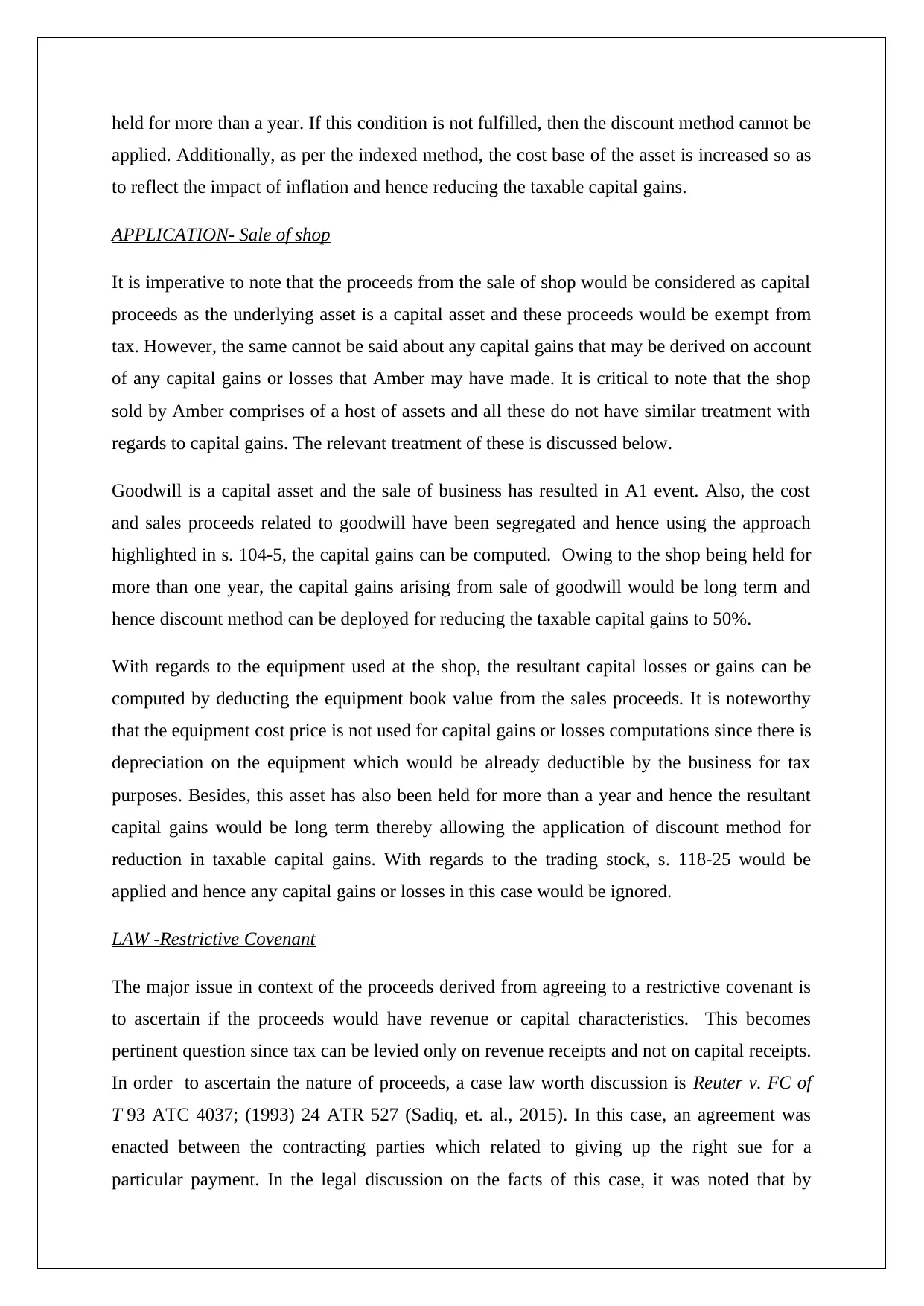
held for more than a year. If this condition is not fulfilled, then the discount method cannot be
applied. Additionally, as per the indexed method, the cost base of the asset is increased so as
to reflect the impact of inflation and hence reducing the taxable capital gains.
APPLICATION- Sale of shop
It is imperative to note that the proceeds from the sale of shop would be considered as capital
proceeds as the underlying asset is a capital asset and these proceeds would be exempt from
tax. However, the same cannot be said about any capital gains that may be derived on account
of any capital gains or losses that Amber may have made. It is critical to note that the shop
sold by Amber comprises of a host of assets and all these do not have similar treatment with
regards to capital gains. The relevant treatment of these is discussed below.
Goodwill is a capital asset and the sale of business has resulted in A1 event. Also, the cost
and sales proceeds related to goodwill have been segregated and hence using the approach
highlighted in s. 104-5, the capital gains can be computed. Owing to the shop being held for
more than one year, the capital gains arising from sale of goodwill would be long term and
hence discount method can be deployed for reducing the taxable capital gains to 50%.
With regards to the equipment used at the shop, the resultant capital losses or gains can be
computed by deducting the equipment book value from the sales proceeds. It is noteworthy
that the equipment cost price is not used for capital gains or losses computations since there is
depreciation on the equipment which would be already deductible by the business for tax
purposes. Besides, this asset has also been held for more than a year and hence the resultant
capital gains would be long term thereby allowing the application of discount method for
reduction in taxable capital gains. With regards to the trading stock, s. 118-25 would be
applied and hence any capital gains or losses in this case would be ignored.
LAW -Restrictive Covenant
The major issue in context of the proceeds derived from agreeing to a restrictive covenant is
to ascertain if the proceeds would have revenue or capital characteristics. This becomes
pertinent question since tax can be levied only on revenue receipts and not on capital receipts.
In order to ascertain the nature of proceeds, a case law worth discussion is Reuter v. FC of
T 93 ATC 4037; (1993) 24 ATR 527 (Sadiq, et. al., 2015). In this case, an agreement was
enacted between the contracting parties which related to giving up the right sue for a
particular payment. In the legal discussion on the facts of this case, it was noted that by
applied. Additionally, as per the indexed method, the cost base of the asset is increased so as
to reflect the impact of inflation and hence reducing the taxable capital gains.
APPLICATION- Sale of shop
It is imperative to note that the proceeds from the sale of shop would be considered as capital
proceeds as the underlying asset is a capital asset and these proceeds would be exempt from
tax. However, the same cannot be said about any capital gains that may be derived on account
of any capital gains or losses that Amber may have made. It is critical to note that the shop
sold by Amber comprises of a host of assets and all these do not have similar treatment with
regards to capital gains. The relevant treatment of these is discussed below.
Goodwill is a capital asset and the sale of business has resulted in A1 event. Also, the cost
and sales proceeds related to goodwill have been segregated and hence using the approach
highlighted in s. 104-5, the capital gains can be computed. Owing to the shop being held for
more than one year, the capital gains arising from sale of goodwill would be long term and
hence discount method can be deployed for reducing the taxable capital gains to 50%.
With regards to the equipment used at the shop, the resultant capital losses or gains can be
computed by deducting the equipment book value from the sales proceeds. It is noteworthy
that the equipment cost price is not used for capital gains or losses computations since there is
depreciation on the equipment which would be already deductible by the business for tax
purposes. Besides, this asset has also been held for more than a year and hence the resultant
capital gains would be long term thereby allowing the application of discount method for
reduction in taxable capital gains. With regards to the trading stock, s. 118-25 would be
applied and hence any capital gains or losses in this case would be ignored.
LAW -Restrictive Covenant
The major issue in context of the proceeds derived from agreeing to a restrictive covenant is
to ascertain if the proceeds would have revenue or capital characteristics. This becomes
pertinent question since tax can be levied only on revenue receipts and not on capital receipts.
In order to ascertain the nature of proceeds, a case law worth discussion is Reuter v. FC of
T 93 ATC 4037; (1993) 24 ATR 527 (Sadiq, et. al., 2015). In this case, an agreement was
enacted between the contracting parties which related to giving up the right sue for a
particular payment. In the legal discussion on the facts of this case, it was noted that by
⊘ This is a preview!⊘
Do you want full access?
Subscribe today to unlock all pages.

Trusted by 1+ million students worldwide
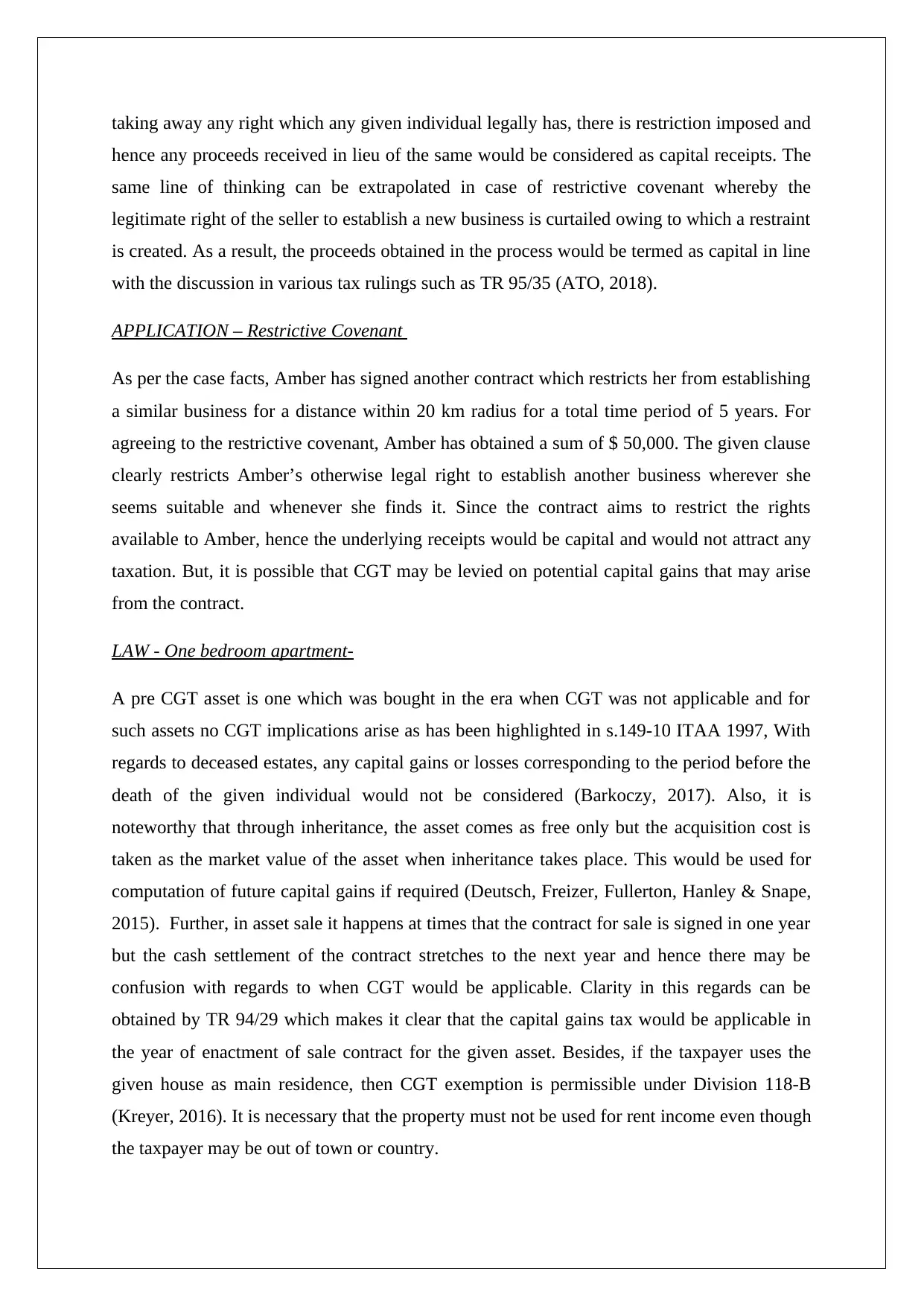
taking away any right which any given individual legally has, there is restriction imposed and
hence any proceeds received in lieu of the same would be considered as capital receipts. The
same line of thinking can be extrapolated in case of restrictive covenant whereby the
legitimate right of the seller to establish a new business is curtailed owing to which a restraint
is created. As a result, the proceeds obtained in the process would be termed as capital in line
with the discussion in various tax rulings such as TR 95/35 (ATO, 2018).
APPLICATION – Restrictive Covenant
As per the case facts, Amber has signed another contract which restricts her from establishing
a similar business for a distance within 20 km radius for a total time period of 5 years. For
agreeing to the restrictive covenant, Amber has obtained a sum of $ 50,000. The given clause
clearly restricts Amber’s otherwise legal right to establish another business wherever she
seems suitable and whenever she finds it. Since the contract aims to restrict the rights
available to Amber, hence the underlying receipts would be capital and would not attract any
taxation. But, it is possible that CGT may be levied on potential capital gains that may arise
from the contract.
LAW - One bedroom apartment-
A pre CGT asset is one which was bought in the era when CGT was not applicable and for
such assets no CGT implications arise as has been highlighted in s.149-10 ITAA 1997, With
regards to deceased estates, any capital gains or losses corresponding to the period before the
death of the given individual would not be considered (Barkoczy, 2017). Also, it is
noteworthy that through inheritance, the asset comes as free only but the acquisition cost is
taken as the market value of the asset when inheritance takes place. This would be used for
computation of future capital gains if required (Deutsch, Freizer, Fullerton, Hanley & Snape,
2015). Further, in asset sale it happens at times that the contract for sale is signed in one year
but the cash settlement of the contract stretches to the next year and hence there may be
confusion with regards to when CGT would be applicable. Clarity in this regards can be
obtained by TR 94/29 which makes it clear that the capital gains tax would be applicable in
the year of enactment of sale contract for the given asset. Besides, if the taxpayer uses the
given house as main residence, then CGT exemption is permissible under Division 118-B
(Kreyer, 2016). It is necessary that the property must not be used for rent income even though
the taxpayer may be out of town or country.
hence any proceeds received in lieu of the same would be considered as capital receipts. The
same line of thinking can be extrapolated in case of restrictive covenant whereby the
legitimate right of the seller to establish a new business is curtailed owing to which a restraint
is created. As a result, the proceeds obtained in the process would be termed as capital in line
with the discussion in various tax rulings such as TR 95/35 (ATO, 2018).
APPLICATION – Restrictive Covenant
As per the case facts, Amber has signed another contract which restricts her from establishing
a similar business for a distance within 20 km radius for a total time period of 5 years. For
agreeing to the restrictive covenant, Amber has obtained a sum of $ 50,000. The given clause
clearly restricts Amber’s otherwise legal right to establish another business wherever she
seems suitable and whenever she finds it. Since the contract aims to restrict the rights
available to Amber, hence the underlying receipts would be capital and would not attract any
taxation. But, it is possible that CGT may be levied on potential capital gains that may arise
from the contract.
LAW - One bedroom apartment-
A pre CGT asset is one which was bought in the era when CGT was not applicable and for
such assets no CGT implications arise as has been highlighted in s.149-10 ITAA 1997, With
regards to deceased estates, any capital gains or losses corresponding to the period before the
death of the given individual would not be considered (Barkoczy, 2017). Also, it is
noteworthy that through inheritance, the asset comes as free only but the acquisition cost is
taken as the market value of the asset when inheritance takes place. This would be used for
computation of future capital gains if required (Deutsch, Freizer, Fullerton, Hanley & Snape,
2015). Further, in asset sale it happens at times that the contract for sale is signed in one year
but the cash settlement of the contract stretches to the next year and hence there may be
confusion with regards to when CGT would be applicable. Clarity in this regards can be
obtained by TR 94/29 which makes it clear that the capital gains tax would be applicable in
the year of enactment of sale contract for the given asset. Besides, if the taxpayer uses the
given house as main residence, then CGT exemption is permissible under Division 118-B
(Kreyer, 2016). It is necessary that the property must not be used for rent income even though
the taxpayer may be out of town or country.
Paraphrase This Document
Need a fresh take? Get an instant paraphrase of this document with our AI Paraphraser
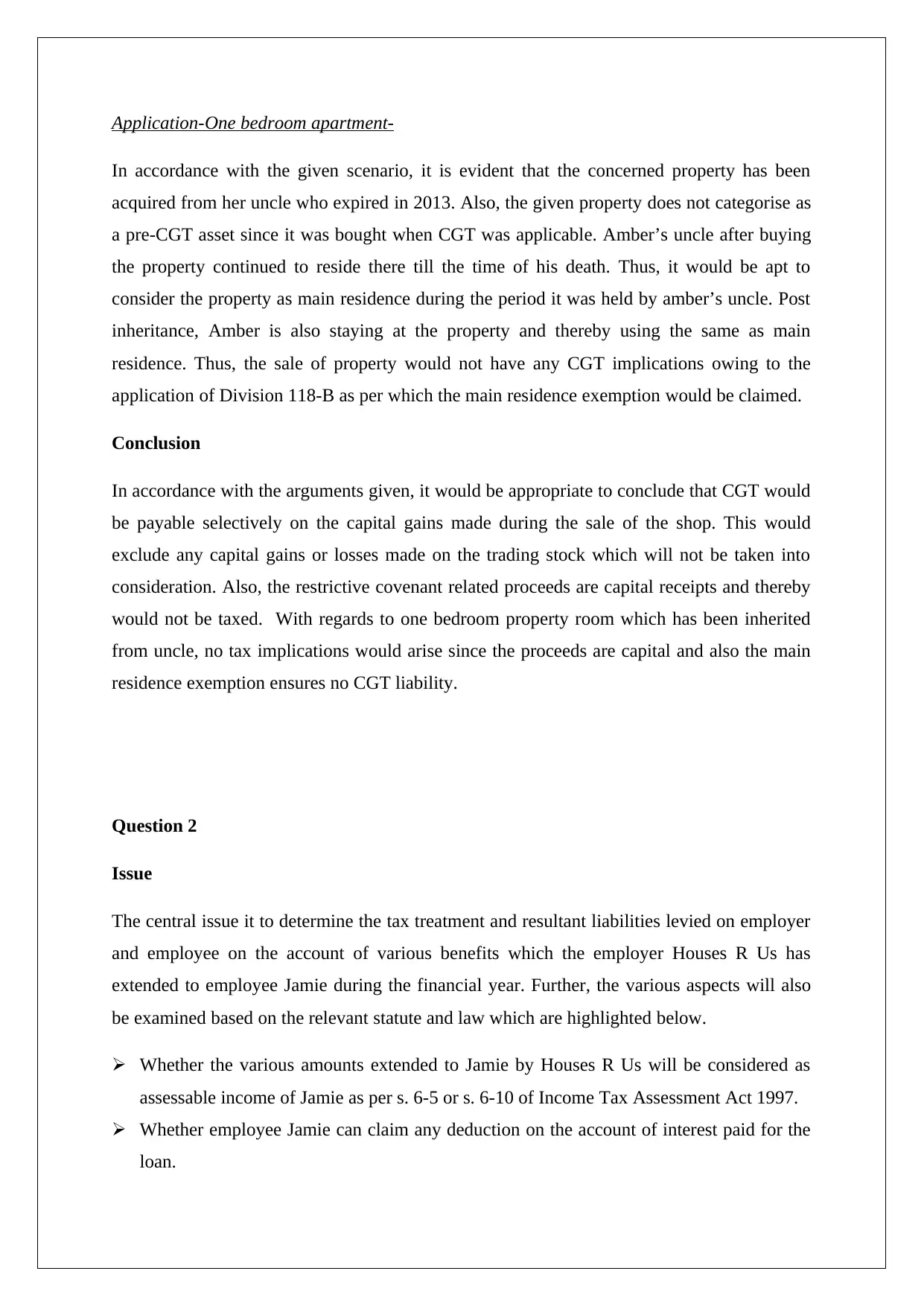
Application-One bedroom apartment-
In accordance with the given scenario, it is evident that the concerned property has been
acquired from her uncle who expired in 2013. Also, the given property does not categorise as
a pre-CGT asset since it was bought when CGT was applicable. Amber’s uncle after buying
the property continued to reside there till the time of his death. Thus, it would be apt to
consider the property as main residence during the period it was held by amber’s uncle. Post
inheritance, Amber is also staying at the property and thereby using the same as main
residence. Thus, the sale of property would not have any CGT implications owing to the
application of Division 118-B as per which the main residence exemption would be claimed.
Conclusion
In accordance with the arguments given, it would be appropriate to conclude that CGT would
be payable selectively on the capital gains made during the sale of the shop. This would
exclude any capital gains or losses made on the trading stock which will not be taken into
consideration. Also, the restrictive covenant related proceeds are capital receipts and thereby
would not be taxed. With regards to one bedroom property room which has been inherited
from uncle, no tax implications would arise since the proceeds are capital and also the main
residence exemption ensures no CGT liability.
Question 2
Issue
The central issue it to determine the tax treatment and resultant liabilities levied on employer
and employee on the account of various benefits which the employer Houses R Us has
extended to employee Jamie during the financial year. Further, the various aspects will also
be examined based on the relevant statute and law which are highlighted below.
Whether the various amounts extended to Jamie by Houses R Us will be considered as
assessable income of Jamie as per s. 6-5 or s. 6-10 of Income Tax Assessment Act 1997.
Whether employee Jamie can claim any deduction on the account of interest paid for the
loan.
In accordance with the given scenario, it is evident that the concerned property has been
acquired from her uncle who expired in 2013. Also, the given property does not categorise as
a pre-CGT asset since it was bought when CGT was applicable. Amber’s uncle after buying
the property continued to reside there till the time of his death. Thus, it would be apt to
consider the property as main residence during the period it was held by amber’s uncle. Post
inheritance, Amber is also staying at the property and thereby using the same as main
residence. Thus, the sale of property would not have any CGT implications owing to the
application of Division 118-B as per which the main residence exemption would be claimed.
Conclusion
In accordance with the arguments given, it would be appropriate to conclude that CGT would
be payable selectively on the capital gains made during the sale of the shop. This would
exclude any capital gains or losses made on the trading stock which will not be taken into
consideration. Also, the restrictive covenant related proceeds are capital receipts and thereby
would not be taxed. With regards to one bedroom property room which has been inherited
from uncle, no tax implications would arise since the proceeds are capital and also the main
residence exemption ensures no CGT liability.
Question 2
Issue
The central issue it to determine the tax treatment and resultant liabilities levied on employer
and employee on the account of various benefits which the employer Houses R Us has
extended to employee Jamie during the financial year. Further, the various aspects will also
be examined based on the relevant statute and law which are highlighted below.
Whether the various amounts extended to Jamie by Houses R Us will be considered as
assessable income of Jamie as per s. 6-5 or s. 6-10 of Income Tax Assessment Act 1997.
Whether employee Jamie can claim any deduction on the account of interest paid for the
loan.
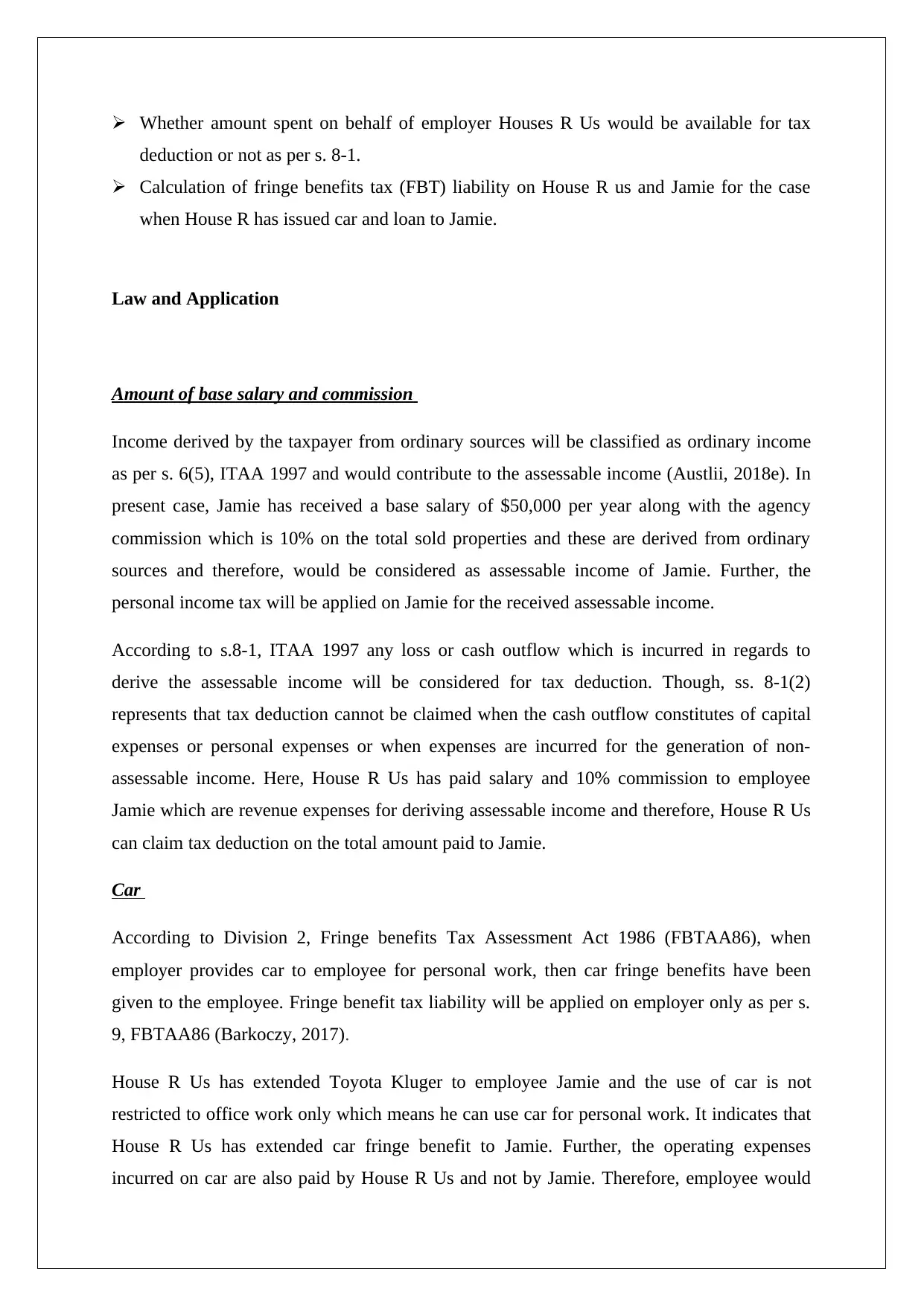
Whether amount spent on behalf of employer Houses R Us would be available for tax
deduction or not as per s. 8-1.
Calculation of fringe benefits tax (FBT) liability on House R us and Jamie for the case
when House R has issued car and loan to Jamie.
Law and Application
Amount of base salary and commission
Income derived by the taxpayer from ordinary sources will be classified as ordinary income
as per s. 6(5), ITAA 1997 and would contribute to the assessable income (Austlii, 2018e). In
present case, Jamie has received a base salary of $50,000 per year along with the agency
commission which is 10% on the total sold properties and these are derived from ordinary
sources and therefore, would be considered as assessable income of Jamie. Further, the
personal income tax will be applied on Jamie for the received assessable income.
According to s.8-1, ITAA 1997 any loss or cash outflow which is incurred in regards to
derive the assessable income will be considered for tax deduction. Though, ss. 8-1(2)
represents that tax deduction cannot be claimed when the cash outflow constitutes of capital
expenses or personal expenses or when expenses are incurred for the generation of non-
assessable income. Here, House R Us has paid salary and 10% commission to employee
Jamie which are revenue expenses for deriving assessable income and therefore, House R Us
can claim tax deduction on the total amount paid to Jamie.
Car
According to Division 2, Fringe benefits Tax Assessment Act 1986 (FBTAA86), when
employer provides car to employee for personal work, then car fringe benefits have been
given to the employee. Fringe benefit tax liability will be applied on employer only as per s.
9, FBTAA86 (Barkoczy, 2017).
House R Us has extended Toyota Kluger to employee Jamie and the use of car is not
restricted to office work only which means he can use car for personal work. It indicates that
House R Us has extended car fringe benefit to Jamie. Further, the operating expenses
incurred on car are also paid by House R Us and not by Jamie. Therefore, employee would
deduction or not as per s. 8-1.
Calculation of fringe benefits tax (FBT) liability on House R us and Jamie for the case
when House R has issued car and loan to Jamie.
Law and Application
Amount of base salary and commission
Income derived by the taxpayer from ordinary sources will be classified as ordinary income
as per s. 6(5), ITAA 1997 and would contribute to the assessable income (Austlii, 2018e). In
present case, Jamie has received a base salary of $50,000 per year along with the agency
commission which is 10% on the total sold properties and these are derived from ordinary
sources and therefore, would be considered as assessable income of Jamie. Further, the
personal income tax will be applied on Jamie for the received assessable income.
According to s.8-1, ITAA 1997 any loss or cash outflow which is incurred in regards to
derive the assessable income will be considered for tax deduction. Though, ss. 8-1(2)
represents that tax deduction cannot be claimed when the cash outflow constitutes of capital
expenses or personal expenses or when expenses are incurred for the generation of non-
assessable income. Here, House R Us has paid salary and 10% commission to employee
Jamie which are revenue expenses for deriving assessable income and therefore, House R Us
can claim tax deduction on the total amount paid to Jamie.
Car
According to Division 2, Fringe benefits Tax Assessment Act 1986 (FBTAA86), when
employer provides car to employee for personal work, then car fringe benefits have been
given to the employee. Fringe benefit tax liability will be applied on employer only as per s.
9, FBTAA86 (Barkoczy, 2017).
House R Us has extended Toyota Kluger to employee Jamie and the use of car is not
restricted to office work only which means he can use car for personal work. It indicates that
House R Us has extended car fringe benefit to Jamie. Further, the operating expenses
incurred on car are also paid by House R Us and not by Jamie. Therefore, employee would
⊘ This is a preview!⊘
Do you want full access?
Subscribe today to unlock all pages.

Trusted by 1+ million students worldwide
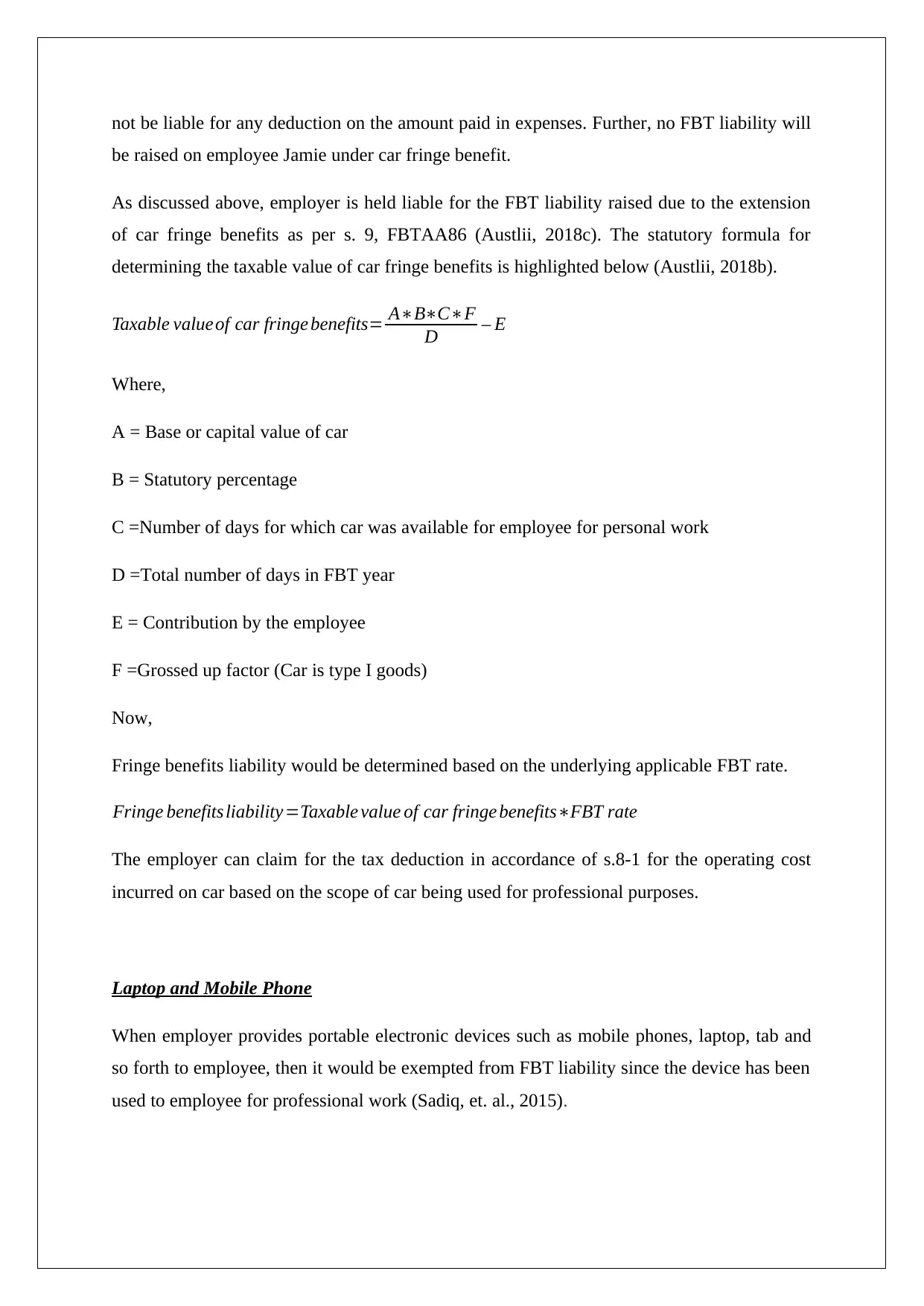
not be liable for any deduction on the amount paid in expenses. Further, no FBT liability will
be raised on employee Jamie under car fringe benefit.
As discussed above, employer is held liable for the FBT liability raised due to the extension
of car fringe benefits as per s. 9, FBTAA86 (Austlii, 2018c). The statutory formula for
determining the taxable value of car fringe benefits is highlighted below (Austlii, 2018b).
Taxable valueof car fringe benefits= A∗B∗C∗F
D – E
Where,
A = Base or capital value of car
B = Statutory percentage
C =Number of days for which car was available for employee for personal work
D =Total number of days in FBT year
E = Contribution by the employee
F =Grossed up factor (Car is type I goods)
Now,
Fringe benefits liability would be determined based on the underlying applicable FBT rate.
Fringe benefits liability=Taxable value of car fringe benefits∗FBT rate
The employer can claim for the tax deduction in accordance of s.8-1 for the operating cost
incurred on car based on the scope of car being used for professional purposes.
Laptop and Mobile Phone
When employer provides portable electronic devices such as mobile phones, laptop, tab and
so forth to employee, then it would be exempted from FBT liability since the device has been
used to employee for professional work (Sadiq, et. al., 2015).
be raised on employee Jamie under car fringe benefit.
As discussed above, employer is held liable for the FBT liability raised due to the extension
of car fringe benefits as per s. 9, FBTAA86 (Austlii, 2018c). The statutory formula for
determining the taxable value of car fringe benefits is highlighted below (Austlii, 2018b).
Taxable valueof car fringe benefits= A∗B∗C∗F
D – E
Where,
A = Base or capital value of car
B = Statutory percentage
C =Number of days for which car was available for employee for personal work
D =Total number of days in FBT year
E = Contribution by the employee
F =Grossed up factor (Car is type I goods)
Now,
Fringe benefits liability would be determined based on the underlying applicable FBT rate.
Fringe benefits liability=Taxable value of car fringe benefits∗FBT rate
The employer can claim for the tax deduction in accordance of s.8-1 for the operating cost
incurred on car based on the scope of car being used for professional purposes.
Laptop and Mobile Phone
When employer provides portable electronic devices such as mobile phones, laptop, tab and
so forth to employee, then it would be exempted from FBT liability since the device has been
used to employee for professional work (Sadiq, et. al., 2015).
Paraphrase This Document
Need a fresh take? Get an instant paraphrase of this document with our AI Paraphraser
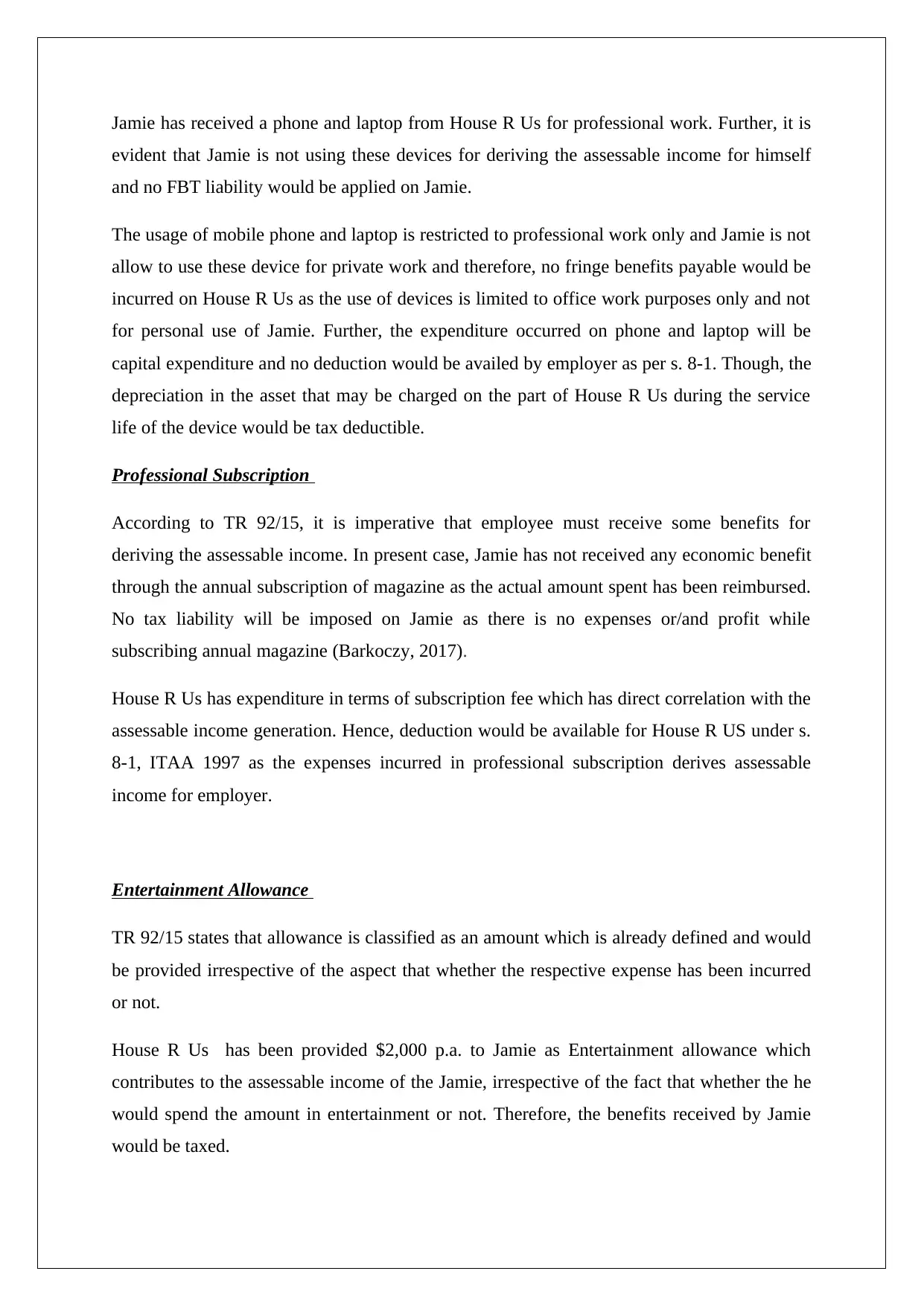
Jamie has received a phone and laptop from House R Us for professional work. Further, it is
evident that Jamie is not using these devices for deriving the assessable income for himself
and no FBT liability would be applied on Jamie.
The usage of mobile phone and laptop is restricted to professional work only and Jamie is not
allow to use these device for private work and therefore, no fringe benefits payable would be
incurred on House R Us as the use of devices is limited to office work purposes only and not
for personal use of Jamie. Further, the expenditure occurred on phone and laptop will be
capital expenditure and no deduction would be availed by employer as per s. 8-1. Though, the
depreciation in the asset that may be charged on the part of House R Us during the service
life of the device would be tax deductible.
Professional Subscription
According to TR 92/15, it is imperative that employee must receive some benefits for
deriving the assessable income. In present case, Jamie has not received any economic benefit
through the annual subscription of magazine as the actual amount spent has been reimbursed.
No tax liability will be imposed on Jamie as there is no expenses or/and profit while
subscribing annual magazine (Barkoczy, 2017).
House R Us has expenditure in terms of subscription fee which has direct correlation with the
assessable income generation. Hence, deduction would be available for House R US under s.
8-1, ITAA 1997 as the expenses incurred in professional subscription derives assessable
income for employer.
Entertainment Allowance
TR 92/15 states that allowance is classified as an amount which is already defined and would
be provided irrespective of the aspect that whether the respective expense has been incurred
or not.
House R Us has been provided $2,000 p.a. to Jamie as Entertainment allowance which
contributes to the assessable income of the Jamie, irrespective of the fact that whether the he
would spend the amount in entertainment or not. Therefore, the benefits received by Jamie
would be taxed.
evident that Jamie is not using these devices for deriving the assessable income for himself
and no FBT liability would be applied on Jamie.
The usage of mobile phone and laptop is restricted to professional work only and Jamie is not
allow to use these device for private work and therefore, no fringe benefits payable would be
incurred on House R Us as the use of devices is limited to office work purposes only and not
for personal use of Jamie. Further, the expenditure occurred on phone and laptop will be
capital expenditure and no deduction would be availed by employer as per s. 8-1. Though, the
depreciation in the asset that may be charged on the part of House R Us during the service
life of the device would be tax deductible.
Professional Subscription
According to TR 92/15, it is imperative that employee must receive some benefits for
deriving the assessable income. In present case, Jamie has not received any economic benefit
through the annual subscription of magazine as the actual amount spent has been reimbursed.
No tax liability will be imposed on Jamie as there is no expenses or/and profit while
subscribing annual magazine (Barkoczy, 2017).
House R Us has expenditure in terms of subscription fee which has direct correlation with the
assessable income generation. Hence, deduction would be available for House R US under s.
8-1, ITAA 1997 as the expenses incurred in professional subscription derives assessable
income for employer.
Entertainment Allowance
TR 92/15 states that allowance is classified as an amount which is already defined and would
be provided irrespective of the aspect that whether the respective expense has been incurred
or not.
House R Us has been provided $2,000 p.a. to Jamie as Entertainment allowance which
contributes to the assessable income of the Jamie, irrespective of the fact that whether the he
would spend the amount in entertainment or not. Therefore, the benefits received by Jamie
would be taxed.
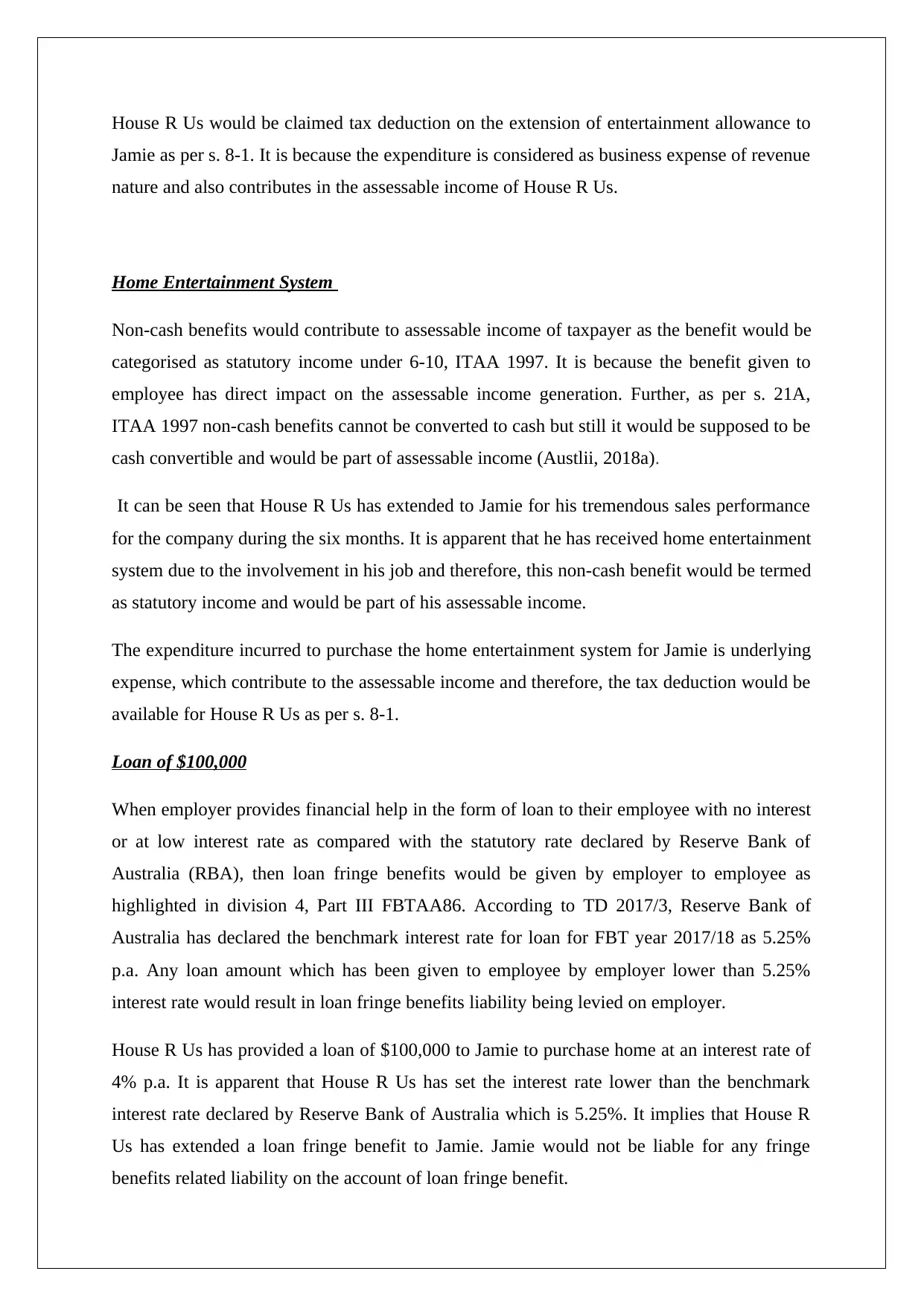
House R Us would be claimed tax deduction on the extension of entertainment allowance to
Jamie as per s. 8-1. It is because the expenditure is considered as business expense of revenue
nature and also contributes in the assessable income of House R Us.
Home Entertainment System
Non-cash benefits would contribute to assessable income of taxpayer as the benefit would be
categorised as statutory income under 6-10, ITAA 1997. It is because the benefit given to
employee has direct impact on the assessable income generation. Further, as per s. 21A,
ITAA 1997 non-cash benefits cannot be converted to cash but still it would be supposed to be
cash convertible and would be part of assessable income (Austlii, 2018a).
It can be seen that House R Us has extended to Jamie for his tremendous sales performance
for the company during the six months. It is apparent that he has received home entertainment
system due to the involvement in his job and therefore, this non-cash benefit would be termed
as statutory income and would be part of his assessable income.
The expenditure incurred to purchase the home entertainment system for Jamie is underlying
expense, which contribute to the assessable income and therefore, the tax deduction would be
available for House R Us as per s. 8-1.
Loan of $100,000
When employer provides financial help in the form of loan to their employee with no interest
or at low interest rate as compared with the statutory rate declared by Reserve Bank of
Australia (RBA), then loan fringe benefits would be given by employer to employee as
highlighted in division 4, Part III FBTAA86. According to TD 2017/3, Reserve Bank of
Australia has declared the benchmark interest rate for loan for FBT year 2017/18 as 5.25%
p.a. Any loan amount which has been given to employee by employer lower than 5.25%
interest rate would result in loan fringe benefits liability being levied on employer.
House R Us has provided a loan of $100,000 to Jamie to purchase home at an interest rate of
4% p.a. It is apparent that House R Us has set the interest rate lower than the benchmark
interest rate declared by Reserve Bank of Australia which is 5.25%. It implies that House R
Us has extended a loan fringe benefit to Jamie. Jamie would not be liable for any fringe
benefits related liability on the account of loan fringe benefit.
Jamie as per s. 8-1. It is because the expenditure is considered as business expense of revenue
nature and also contributes in the assessable income of House R Us.
Home Entertainment System
Non-cash benefits would contribute to assessable income of taxpayer as the benefit would be
categorised as statutory income under 6-10, ITAA 1997. It is because the benefit given to
employee has direct impact on the assessable income generation. Further, as per s. 21A,
ITAA 1997 non-cash benefits cannot be converted to cash but still it would be supposed to be
cash convertible and would be part of assessable income (Austlii, 2018a).
It can be seen that House R Us has extended to Jamie for his tremendous sales performance
for the company during the six months. It is apparent that he has received home entertainment
system due to the involvement in his job and therefore, this non-cash benefit would be termed
as statutory income and would be part of his assessable income.
The expenditure incurred to purchase the home entertainment system for Jamie is underlying
expense, which contribute to the assessable income and therefore, the tax deduction would be
available for House R Us as per s. 8-1.
Loan of $100,000
When employer provides financial help in the form of loan to their employee with no interest
or at low interest rate as compared with the statutory rate declared by Reserve Bank of
Australia (RBA), then loan fringe benefits would be given by employer to employee as
highlighted in division 4, Part III FBTAA86. According to TD 2017/3, Reserve Bank of
Australia has declared the benchmark interest rate for loan for FBT year 2017/18 as 5.25%
p.a. Any loan amount which has been given to employee by employer lower than 5.25%
interest rate would result in loan fringe benefits liability being levied on employer.
House R Us has provided a loan of $100,000 to Jamie to purchase home at an interest rate of
4% p.a. It is apparent that House R Us has set the interest rate lower than the benchmark
interest rate declared by Reserve Bank of Australia which is 5.25%. It implies that House R
Us has extended a loan fringe benefit to Jamie. Jamie would not be liable for any fringe
benefits related liability on the account of loan fringe benefit.
⊘ This is a preview!⊘
Do you want full access?
Subscribe today to unlock all pages.

Trusted by 1+ million students worldwide
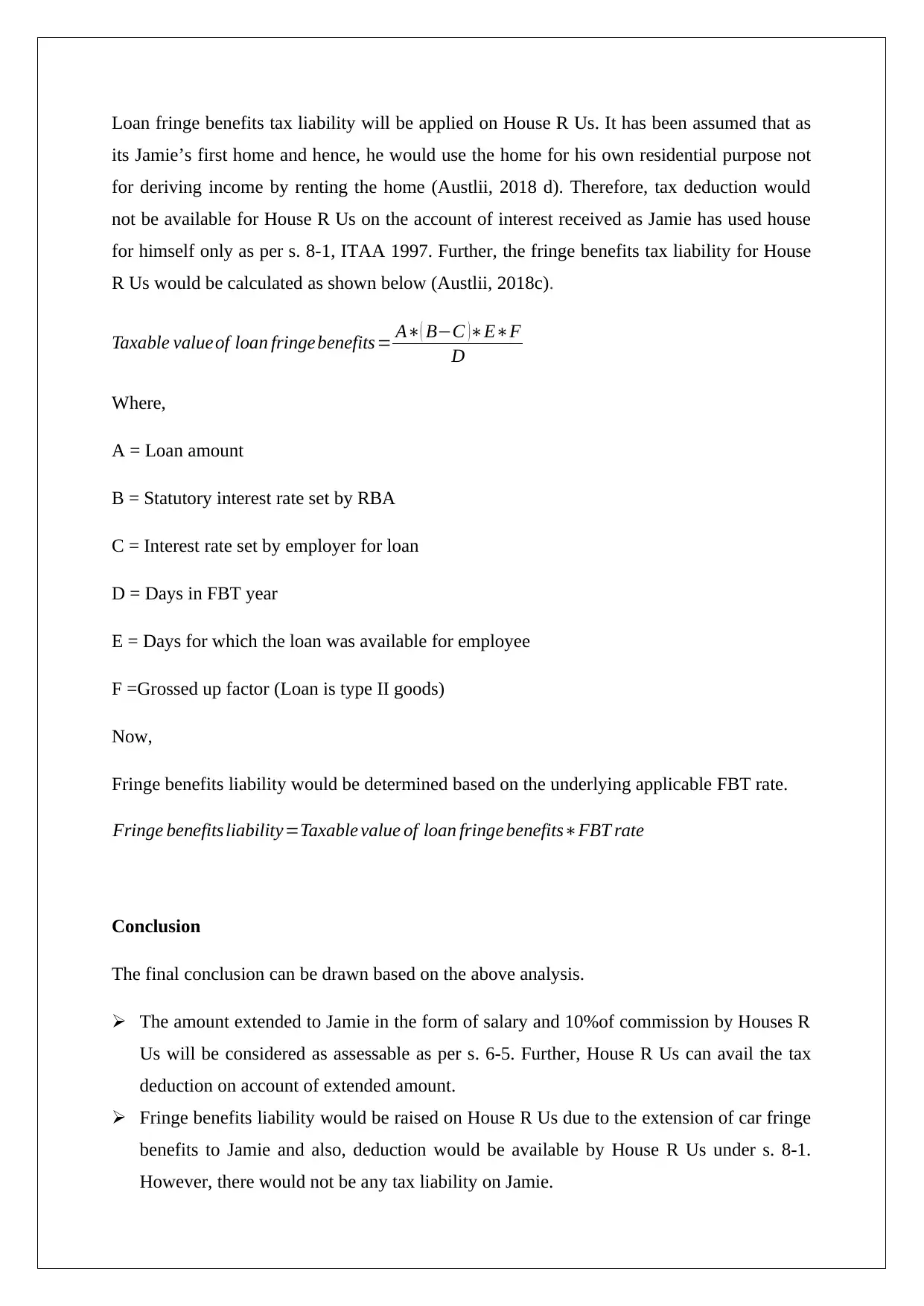
Loan fringe benefits tax liability will be applied on House R Us. It has been assumed that as
its Jamie’s first home and hence, he would use the home for his own residential purpose not
for deriving income by renting the home (Austlii, 2018 d). Therefore, tax deduction would
not be available for House R Us on the account of interest received as Jamie has used house
for himself only as per s. 8-1, ITAA 1997. Further, the fringe benefits tax liability for House
R Us would be calculated as shown below (Austlii, 2018c).
Taxable value of loan fringe benefits= A∗( B−C )∗E∗F
D
Where,
A = Loan amount
B = Statutory interest rate set by RBA
C = Interest rate set by employer for loan
D = Days in FBT year
E = Days for which the loan was available for employee
F =Grossed up factor (Loan is type II goods)
Now,
Fringe benefits liability would be determined based on the underlying applicable FBT rate.
Fringe benefits liability=Taxable value of loan fringe benefits∗FBT rate
Conclusion
The final conclusion can be drawn based on the above analysis.
The amount extended to Jamie in the form of salary and 10%of commission by Houses R
Us will be considered as assessable as per s. 6-5. Further, House R Us can avail the tax
deduction on account of extended amount.
Fringe benefits liability would be raised on House R Us due to the extension of car fringe
benefits to Jamie and also, deduction would be available by House R Us under s. 8-1.
However, there would not be any tax liability on Jamie.
its Jamie’s first home and hence, he would use the home for his own residential purpose not
for deriving income by renting the home (Austlii, 2018 d). Therefore, tax deduction would
not be available for House R Us on the account of interest received as Jamie has used house
for himself only as per s. 8-1, ITAA 1997. Further, the fringe benefits tax liability for House
R Us would be calculated as shown below (Austlii, 2018c).
Taxable value of loan fringe benefits= A∗( B−C )∗E∗F
D
Where,
A = Loan amount
B = Statutory interest rate set by RBA
C = Interest rate set by employer for loan
D = Days in FBT year
E = Days for which the loan was available for employee
F =Grossed up factor (Loan is type II goods)
Now,
Fringe benefits liability would be determined based on the underlying applicable FBT rate.
Fringe benefits liability=Taxable value of loan fringe benefits∗FBT rate
Conclusion
The final conclusion can be drawn based on the above analysis.
The amount extended to Jamie in the form of salary and 10%of commission by Houses R
Us will be considered as assessable as per s. 6-5. Further, House R Us can avail the tax
deduction on account of extended amount.
Fringe benefits liability would be raised on House R Us due to the extension of car fringe
benefits to Jamie and also, deduction would be available by House R Us under s. 8-1.
However, there would not be any tax liability on Jamie.
Paraphrase This Document
Need a fresh take? Get an instant paraphrase of this document with our AI Paraphraser
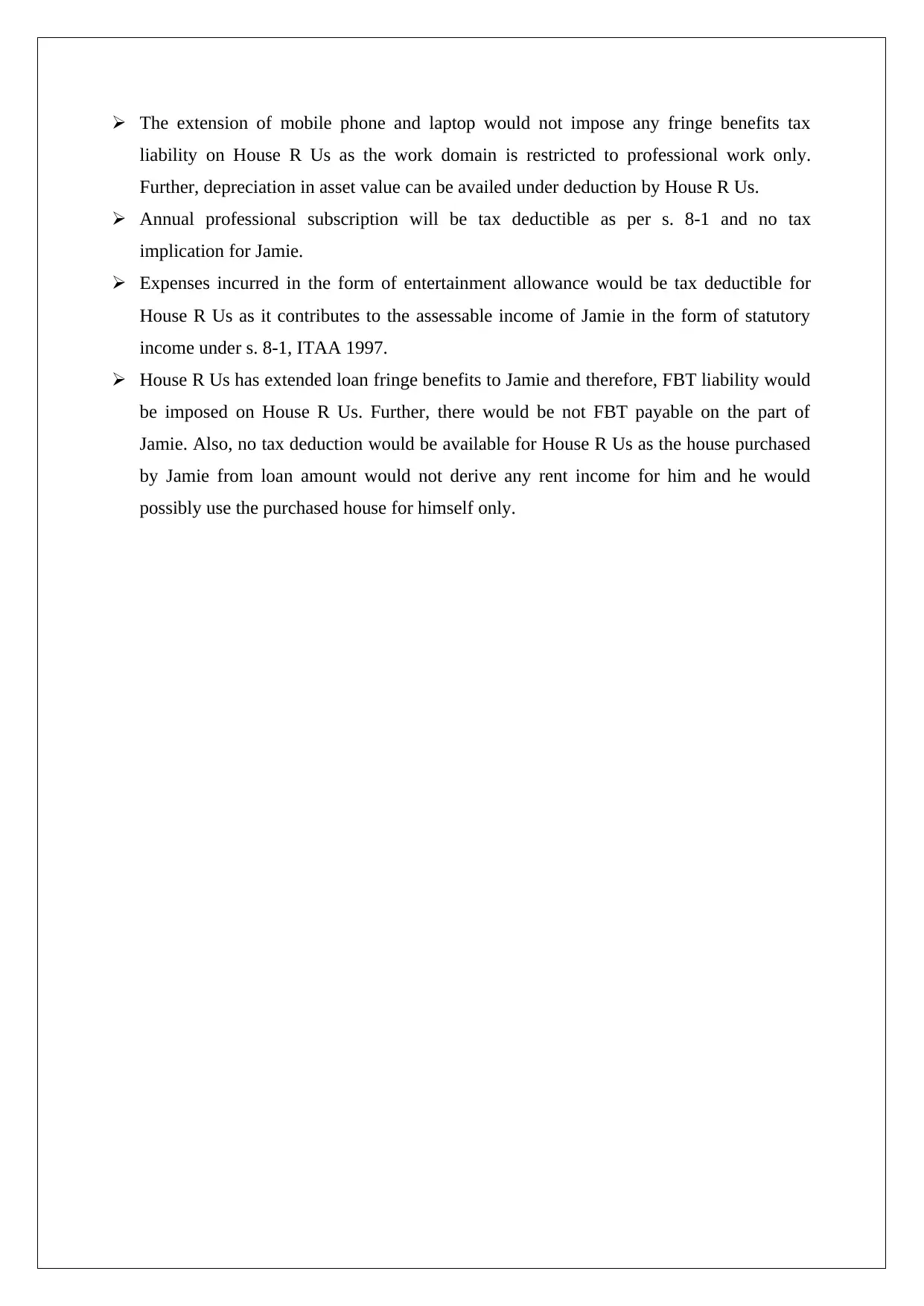
The extension of mobile phone and laptop would not impose any fringe benefits tax
liability on House R Us as the work domain is restricted to professional work only.
Further, depreciation in asset value can be availed under deduction by House R Us.
Annual professional subscription will be tax deductible as per s. 8-1 and no tax
implication for Jamie.
Expenses incurred in the form of entertainment allowance would be tax deductible for
House R Us as it contributes to the assessable income of Jamie in the form of statutory
income under s. 8-1, ITAA 1997.
House R Us has extended loan fringe benefits to Jamie and therefore, FBT liability would
be imposed on House R Us. Further, there would be not FBT payable on the part of
Jamie. Also, no tax deduction would be available for House R Us as the house purchased
by Jamie from loan amount would not derive any rent income for him and he would
possibly use the purchased house for himself only.
liability on House R Us as the work domain is restricted to professional work only.
Further, depreciation in asset value can be availed under deduction by House R Us.
Annual professional subscription will be tax deductible as per s. 8-1 and no tax
implication for Jamie.
Expenses incurred in the form of entertainment allowance would be tax deductible for
House R Us as it contributes to the assessable income of Jamie in the form of statutory
income under s. 8-1, ITAA 1997.
House R Us has extended loan fringe benefits to Jamie and therefore, FBT liability would
be imposed on House R Us. Further, there would be not FBT payable on the part of
Jamie. Also, no tax deduction would be available for House R Us as the house purchased
by Jamie from loan amount would not derive any rent income for him and he would
possibly use the purchased house for himself only.
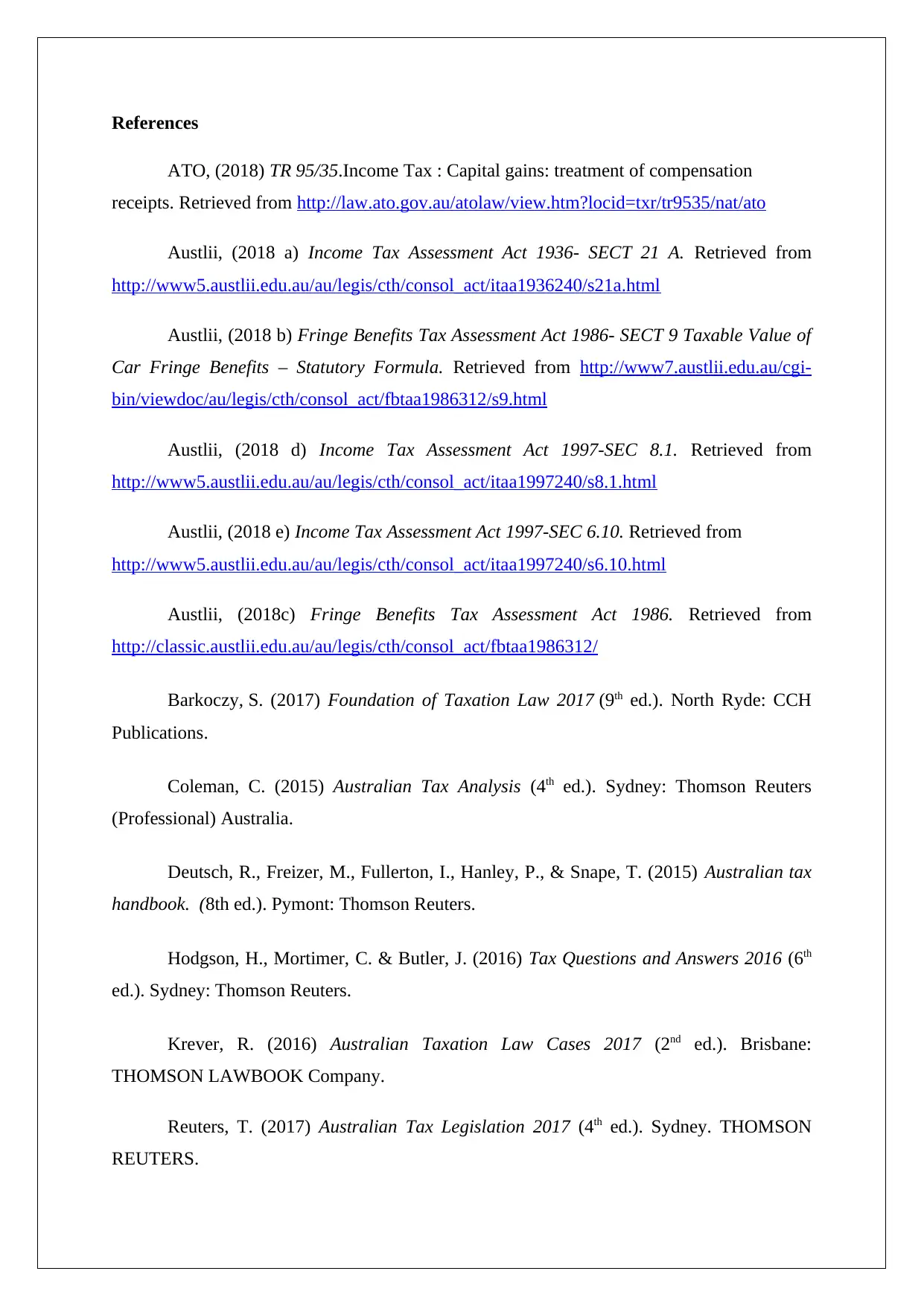
References
ATO, (2018) TR 95/35.Income Tax : Capital gains: treatment of compensation
receipts. Retrieved from http://law.ato.gov.au/atolaw/view.htm?locid=txr/tr9535/nat/ato
Austlii, (2018 a) Income Tax Assessment Act 1936- SECT 21 A. Retrieved from
http://www5.austlii.edu.au/au/legis/cth/consol_act/itaa1936240/s21a.html
Austlii, (2018 b) Fringe Benefits Tax Assessment Act 1986- SECT 9 Taxable Value of
Car Fringe Benefits – Statutory Formula. Retrieved from http://www7.austlii.edu.au/cgi-
bin/viewdoc/au/legis/cth/consol_act/fbtaa1986312/s9.html
Austlii, (2018 d) Income Tax Assessment Act 1997-SEC 8.1. Retrieved from
http://www5.austlii.edu.au/au/legis/cth/consol_act/itaa1997240/s8.1.html
Austlii, (2018 e) Income Tax Assessment Act 1997-SEC 6.10. Retrieved from
http://www5.austlii.edu.au/au/legis/cth/consol_act/itaa1997240/s6.10.html
Austlii, (2018c) Fringe Benefits Tax Assessment Act 1986. Retrieved from
http://classic.austlii.edu.au/au/legis/cth/consol_act/fbtaa1986312/
Barkoczy, S. (2017) Foundation of Taxation Law 2017 (9th ed.). North Ryde: CCH
Publications.
Coleman, C. (2015) Australian Tax Analysis (4th ed.). Sydney: Thomson Reuters
(Professional) Australia.
Deutsch, R., Freizer, M., Fullerton, I., Hanley, P., & Snape, T. (2015) Australian tax
handbook. (8th ed.). Pymont: Thomson Reuters.
Hodgson, H., Mortimer, C. & Butler, J. (2016) Tax Questions and Answers 2016 (6th
ed.). Sydney: Thomson Reuters.
Krever, R. (2016) Australian Taxation Law Cases 2017 (2nd ed.). Brisbane:
THOMSON LAWBOOK Company.
Reuters, T. (2017) Australian Tax Legislation 2017 (4th ed.). Sydney. THOMSON
REUTERS.
ATO, (2018) TR 95/35.Income Tax : Capital gains: treatment of compensation
receipts. Retrieved from http://law.ato.gov.au/atolaw/view.htm?locid=txr/tr9535/nat/ato
Austlii, (2018 a) Income Tax Assessment Act 1936- SECT 21 A. Retrieved from
http://www5.austlii.edu.au/au/legis/cth/consol_act/itaa1936240/s21a.html
Austlii, (2018 b) Fringe Benefits Tax Assessment Act 1986- SECT 9 Taxable Value of
Car Fringe Benefits – Statutory Formula. Retrieved from http://www7.austlii.edu.au/cgi-
bin/viewdoc/au/legis/cth/consol_act/fbtaa1986312/s9.html
Austlii, (2018 d) Income Tax Assessment Act 1997-SEC 8.1. Retrieved from
http://www5.austlii.edu.au/au/legis/cth/consol_act/itaa1997240/s8.1.html
Austlii, (2018 e) Income Tax Assessment Act 1997-SEC 6.10. Retrieved from
http://www5.austlii.edu.au/au/legis/cth/consol_act/itaa1997240/s6.10.html
Austlii, (2018c) Fringe Benefits Tax Assessment Act 1986. Retrieved from
http://classic.austlii.edu.au/au/legis/cth/consol_act/fbtaa1986312/
Barkoczy, S. (2017) Foundation of Taxation Law 2017 (9th ed.). North Ryde: CCH
Publications.
Coleman, C. (2015) Australian Tax Analysis (4th ed.). Sydney: Thomson Reuters
(Professional) Australia.
Deutsch, R., Freizer, M., Fullerton, I., Hanley, P., & Snape, T. (2015) Australian tax
handbook. (8th ed.). Pymont: Thomson Reuters.
Hodgson, H., Mortimer, C. & Butler, J. (2016) Tax Questions and Answers 2016 (6th
ed.). Sydney: Thomson Reuters.
Krever, R. (2016) Australian Taxation Law Cases 2017 (2nd ed.). Brisbane:
THOMSON LAWBOOK Company.
Reuters, T. (2017) Australian Tax Legislation 2017 (4th ed.). Sydney. THOMSON
REUTERS.
⊘ This is a preview!⊘
Do you want full access?
Subscribe today to unlock all pages.

Trusted by 1+ million students worldwide
1 out of 13
Related Documents
Your All-in-One AI-Powered Toolkit for Academic Success.
+13062052269
info@desklib.com
Available 24*7 on WhatsApp / Email
![[object Object]](/_next/static/media/star-bottom.7253800d.svg)
Unlock your academic potential
Copyright © 2020–2025 A2Z Services. All Rights Reserved. Developed and managed by ZUCOL.




